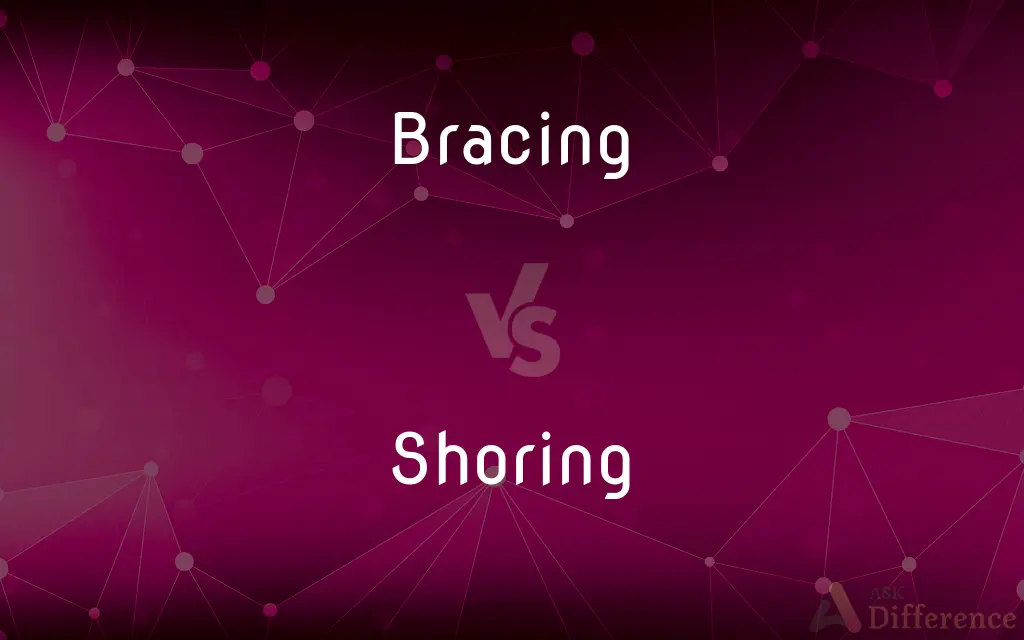Bracing vs. Shoring — What's the Difference?
By Maham Liaqat & Urooj Arif — Updated on March 27, 2024
Bracing is the process of providing structural support to prevent collapse or movement, commonly used in wall and framework stabilization; shoring is a specific technique aimed at supporting or stabilizing buildings, trenches, or excavations.

Difference Between Bracing and Shoring
Table of Contents
ADVERTISEMENT
Key Differences
Bracing and shoring are both critical in construction and engineering, providing essential support to structures, but they serve slightly different purposes and are applied in distinct contexts. Bracing is a broader term that encompasses the use of diagonal supports to strengthen and stabilize structures against lateral forces like wind or seismic activity. It is commonly applied in the stabilization of walls and frameworks, ensuring that the structure remains upright and intact. Shoring, on the other hand, is primarily concerned with supporting the vertical loads of a structure to prevent collapse, especially during construction, repairs, or after a structural failure. Shoring systems are typically temporary and are used to support buildings, vessels, or trenches when the original load-bearing elements are weakened or removed.
Bracing can be a permanent fixture in buildings or temporary during construction phases to add rigidity and prevent deformation. Shoring techniques include the use of hydraulic jacks, timber, and metal supports to hold up walls, floors, and other parts of buildings during the critical phases of construction or renovation.
While bracing is about enhancing the structural integrity against lateral forces, shoring is a method of temporarily substituting or reinforcing the vertical support system of a structure. Bracing can be seen as a measure to tie structural elements together, preventing them from buckling under stress, whereas shoring is used to hold up parts of a structure that are at risk of collapsing due to inadequate support.
In practice, the use of bracing and shoring often overlaps in construction projects, especially in complex structures or those undergoing significant alteration. Both techniques are vital for ensuring safety and stability, but their specific applications depend on the structural challenges and the phase of the construction process.
Despite their differences, the goal of both bracing and shoring is to ensure the safety and longevity of structures. Engineers and construction professionals carefully plan and implement these supports based on the structural needs, the expected loads, and the project's overall requirements, ensuring that buildings and other constructions can withstand both the forces of nature and the stresses of their intended use.
ADVERTISEMENT
Comparison Chart
Purpose
To provide lateral support and stability.
To support vertical loads temporarily.
Application
Wall and framework stabilization.
Construction, repairs, or structural support.
Focus
Against lateral forces (e.g., wind, seismic activity).
Vertical support during critical phases.
Nature
Can be permanent or temporary.
Primarily temporary.
Techniques
Diagonal supports, cross-bracing.
Hydraulic jacks, timber, metal supports.
Use Cases
Enhancing structural integrity, preventing deformation.
Preventing collapse during construction/repairs.
Implementation
Tying structural elements together.
Substituting or reinforcing vertical support.
Compare with Definitions
Bracing
Enhancing structural rigidity against lateral forces.
The building's bracing was reinforced to withstand earthquakes.
Shoring
Focuses on preventing collapse by supporting vertical loads.
Hydraulic shoring systems were installed to secure the excavation site.
Bracing
Prevents structural elements from buckling.
Bracing in the roof trusses prevents them from collapsing under heavy snow.
Shoring
Utilizes various materials like timber and metal.
Timber shoring was used in the historic building to preserve its integrity during updates.
Bracing
Use of diagonal supports in frameworks.
Diagonal bracing was added to the scaffolding for extra stability.
Shoring
Critical for safety in construction and renovation.
The construction team used shoring to safely excavate the site for the new basement.
Bracing
Can be integrated into the design for long-term support.
The bridge design includes permanent bracing for added durability.
Shoring
Often employed in response to structural failure.
After the fire, shoring stabilized the structure to allow for safe entry and assessment.
Bracing
Common in both construction and renovation projects.
Temporary bracing was used during the renovation to support the existing walls.
Shoring
Temporarily supports structures during construction or repair.
Shoring was necessary to support the walls while the foundation was repaired.
Bracing
Invigorating or refreshing; strengthening
A bracing tonic.
Shoring
Shoring is the process of temporarily supporting a building, vessel, structure, or trench with shores (props) when in danger of collapse or during repairs or alterations. Shoring comes from shore, a timber or metal prop.
Bracing
A support; a brace.
Shoring
The act or operation of propping with shores.
Bracing
Braces considered as a group.
Shoring
A system of supporting shores.
Bracing
Present participle of brace
Shoring
Present participle of shore
Bracing
Invigorating or stimulating.
Shoring
Temporary bracing used to prevent something, such as a tunnel, trench, or wall, from collapse.
Bracing
(uncountable) That which braces.
Shoring
The act of supporting or strengthening with a prop or shore.
Bracing
(countable) A brace.
Shoring
A system of props; props, collectively.
Bracing
(US) A form of the military attention stance.
Shoring
A beam or timber that is propped against a structure to provide support
Bracing
Imparting strength or tone; strengthening; invigorating; as, a bracing north wind.
Shoring
The act of propping up with shores
Bracing
The act of strengthening, supporting, or propping, with a brace or braces; the state of being braced.
Bracing
Any system of braces; braces, collectively; as, the bracing of a truss.
Bracing
A structural member used to stiffen a framework
Bracing
Imparting vitality and energy;
The bracing mountain air
Common Curiosities
What is the main difference between bracing and shoring?
Bracing provides lateral support to structures, while shoring supports vertical loads, particularly in temporary construction or repair situations.
Is shoring only used during construction?
While primarily used during construction, shoring is also critical for repairs, renovations, or after a structural failure to ensure safety.
What role does bracing play in seismic activity regions?
In seismic regions, bracing is crucial for preventing buildings from collapsing by enhancing resistance to lateral forces.
Can shoring be used for non-building structures like trenches?
Yes, shoring is also used to support trenches and excavations, preventing collapses during construction activities.
What happens if bracing or shoring fails?
Failure of bracing or shoring can lead to structural collapse or significant damage, emphasizing the importance of proper design and installation.
Can both bracing and shoring be used in the same project?
Yes, many construction projects utilize both bracing and shoring to address different structural support needs effectively.
How do I know if my project needs bracing or shoring?
The need for bracing or shoring depends on the structural assessment, focusing on whether lateral or vertical support is required.
How is the safety of shoring ensured during construction?
The safety of shoring is ensured through careful planning, engineering assessments, and adherence to construction standards and regulations.
Can bracing be a permanent part of a structure?
Yes, bracing can be designed as a permanent feature to enhance the structural integrity against lateral forces.
Are there different materials used for bracing and shoring?
Both techniques can utilize various materials, but the choice depends on the specific support required and the nature of the project.
Share Your Discovery

Previous Comparison
Column vs. Post
Next Comparison
Monarchy vs. TheocracyAuthor Spotlight
Written by
Maham LiaqatCo-written by
Urooj ArifUrooj is a skilled content writer at Ask Difference, known for her exceptional ability to simplify complex topics into engaging and informative content. With a passion for research and a flair for clear, concise writing, she consistently delivers articles that resonate with our diverse audience.














































